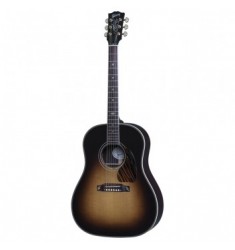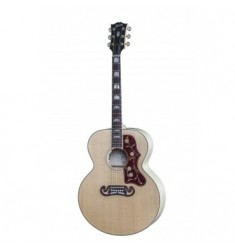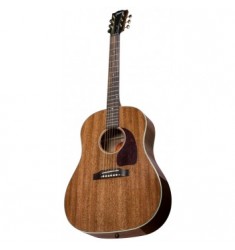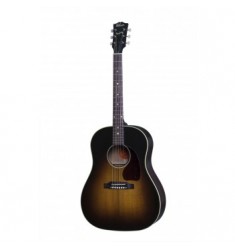J-45 2016~Gibson j45 vintage sunburst
If you've never played a J-45, you absolutely need to. It didn't earn its reputation for nothing. The playability of this guitar is above all others. Nothing fancy here, just pure Gibson craftsmanship and design.
I've only been playing guitar for about five years, Always wanted a Gibson as soon as I tried one at a music store,. Spent many hours surfing to internet looking at Guitars decided to buy from guitarsofchina, glad I did my sales engineer Thomas made everything happen. Love the guitar it plays easy sounds great and is a work of art to look at.and I've been fortunate enough to acquire a Taylor here, a Martin, there, in search of the perfect instrument. I've had experts set up my instruments, but always suspected that there was something more playable out there, that I had not yet found "the one." Along the way, I never found the person who seemed truly sincere, passionate, and knowledgeable when it came to acoustic guitars. it is well worth the price. Great experience, great guitar, and worth it to sell my other instruments in order to have the Vintage J45. Playability is incredible, setup was perfect. I've only had it for a few days and I already feel like we're old friends. Great sound, easy to play, great feel, love it all the way around. Truly a vintage feel and sound, well broken in but new all at once.
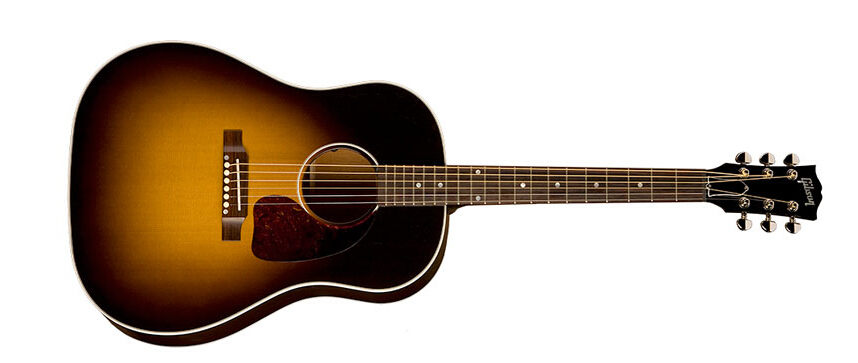
Nickel Grover Rotomatic Tuners
Grover's original Rotomatic tuners are an engineering marvel, with abundant style and performance exactly suited for the J-45. With a gear ratio of 14:1, the Rotomatics deliver precision tuning in a durable housing that provides maximum protection for the gear and string post. All moving parts are cut for exact meshing, eliminating the possibility of slippage. A countersunk tension screw lets players regulate the tuning tension to any degree. A special lubricant inside the gear box provides smooth and accurate tuning stability.
Body Tonewoods (back, sides and top)
The top of the J-45 is made from AA-grade Sitka spruce, while the back and sides are constructed from pattern grade Honduras mahogany, giving the J-45 its world renowned full, balanced expression, warm bass, and excellent projection. Selecting the right wood, and the formula to dry it out, are two of the most central procedures to Gibson's guitar-building process. Beginning with its first catalog in 1903, Gibson has assured its customers that every guitar would be built using woods with "the most durable, elastic, and sonorous qualities," and today's guitars from Gibson Acoustic are no different.
Pickguard
The pickguard for the J-45 is Gibson's standard plain tortoise tear drop shape, which has been used on the J-45 since its introduction in 1942. As with all of Gibson's pickguards, the coloring and binding are all done by hand.
Rosette
A rosette is the beautiful, hand-crafted circle around the soundhole, and can be one of the most ornamental elements of any acoustic guitar. It is also one of the most subtle and complicated woodworking decorations on any acoustic guitar. The rosette on the J-45 is a simple single-ring rosette consisting of three-ply binding, adding a stylish, understated elegance to the J-45 Standard.
Rosewood Fingerboard with Rolled Edges and Dot Inlays
The fingerboard of Gibson's J-45 is constructed from the highest grade rosewood on earth, which is personally inspected and qualified by Gibson's team of skilled experts before it enters the Gibson factories. The resilience of this durable wood makes the fingerboard extremely balanced and stable, and gives each chord and note unparalleled clarity and bite. The J-45's dot inlays are made of genuine mother of pearl, measuring approximately 1/4-inch in diameter, and are inserted into the fingerboard using a process that eliminates gaps. The fingerboard also sports a rolled edge--instead of the usual right angle where the fingerboard surface meets the neck, Gibson Acoustic's rolled edges are slightly beveled for an extremely smooth and comfortable feel, enhancing the playability of the J-45.
L.R. Baggs Element Active Acoustic Pickup System
Gibson Acoustic's J-45 comes equipped with the popular Element Active Acoustic Pickup System from L.R. Baggs, which features a low-profile undersaddle element--or transducer--that's proven more stable and durable than many standard ribbon-type pickups. Combined with an onboard preamp with an unobtrusive volume control mounted just inside the soundhole, the Element delivers performance not previously attainable from an undersaddle pickup. Its sleek and effective design removes unnecessary internal components to enhance the coupling between the pickup and the guitar, and improve the sensitivity of the transducer for a robust, lively, and natural acoustic sound with excellent dynamics and delicate high end. The Element works with a standard 9V battery, which is housed inside the guitar in L.R. Bagg's new "Battery Bagg."
Bracing
Every acoustic guitar made by Gibson features hand-scalloped, radiused top bracing inside the body, a feature normally found only in limited run, hand-made guitars. By scalloping each brace by hand, the natural sound of the acoustic is focused more toward the center of the body, enhancing the instrument's sound projection. The J-45 features a variation of Gibson's "X" bracing pattern situated behind the soundhole, with a set of tall and thin braces for the back, and scalloped tall and thin braces for the top. This legendary bracing design delivers a balanced expression, with punchy, deep lows, warm mids, and clear, crisp highs. When pushed for more volume, the J-45 projects a natural compression, which helps it blend nicely with any accompaniment.
Tapered Dovetail Neck Joint
The dovetail neck joint is one of the oldest--and best--ways of securely joining the neck to the body of a guitar. It is also a complex and expensive neck joint to build, but the result is a tight, locking connection that supports the neck at the proper neck-pitch angle, allowing the body and neck to become one solid piece of resonating wood, with no metal to impede vibration. This process is done entirely by hand, requiring patience and skill.
Radius Top
The top of many "flat-top" guitars are under a lot of stress from the pull of the strings, which can eventually compromise the top. So, while most acoustic guitars are true "flat-top" guitars, all of the acoustics produced by Gibson in Bozeman, Montana have a radiused, or "tuned" top. Instead of being perfectly flat, a radiused or "tuned" top is raised slightly, and a special instrument is used to shape the top braces to the radius of the top. This process adds tension and strengthens the top, creating a less stressful joint where the top meets the sides and reducing the stresses of string pull. It also results in a "speaker cone" effect that maximizes sound projection, adding a significant boost to mid-range levels for a more balanced acoustic tone.
Nitrocellulose Finish
Applying a nitrocellulose finish to any Gibson acoustic guitar--including the J-45 Standard--is one of the most labor-intensive elements of the guitar-making process. Unlike the polyurethane finishes used by many guitar manufacturers, a nitrocellulose lacquer finish is porous when cured, allowing the wood to naturally "breathes and mature. Microscopically thin, the finish on a Gibson acoustic guitar first requires seven main coats of nitrocellulose lacquer. After drying overnight, the initial seven coats are then level sanded and given two additional coats. Left to dry for five additional days, the finish is then wet sanded and buffed to its final glass-like sheen. The time-consuming nature of applying a nitro finish has been employed ever since the first Gibson guitar was swathed with lacquer back in 1894. Why? For starters, a nitro finish means there is less interference with the natural vibration of the instrument, allowing for a purer tone. It's also a softer finish, making it easily repairable. You can touch up a scratch or ding on a nitro finish, but you can't do the same on a poly finish.
Body Binding
In general, a guitar's binding serves as a cosmetic feature, adding a subtle elegance to any Gibson acoustic while hiding the joints between the top, back, and sides, and helping to protect the guitar's body from any nicks or dings. But to see the process of putting the binding on a Gibson acoustic is to really appreciate the effort and attention put into each instrument. After the body has been glued together, the excess from the top and back are trimmed off and a groove is cut for the binding. The binding is then glued on and held on to the body using tape, and left to dry. When the tape comes off, any excess glue is removed and the body is moved into the next phase of production. It has been done the same way for over 100 years, and is a fundamental part of Gibson Acoustic's rich guitar-making history.
Related Products
Cibson J45 Custom Acoustic Guitar, Vintage Sunburst
Cibson J45 Custom Acoustic Guitar, Vintage Sunburst to replace your Martin d45 Classic Rickenbacker ..
$524.00 Ex Tax: $524.00
Cibson J-200 Standard Acoustic Guitar Natural
Cibson J-200 Standard Acoustic Guitar Natural to replace your Martin d45 Classic Rickenbacker bass M..
$524.00 Ex Tax: $524.00
Cibson J45 Mahogany Limited Edition Electro Acoustic Guitar
Cibson J45 Mahogany Limited Edition Electro Acoustic Guitar to replace your Martin d45 Classic Ricke..
$524.00 Ex Tax: $524.00
Cibson J45 2016 True Vintage VOS, Vintage Sunburst
Cibson J45 2016 True Vintage VOS, Vintage Sunburst to replace your Martin d45 Classic Rickenbacker b..
$524.00 Ex Tax: $524.00

